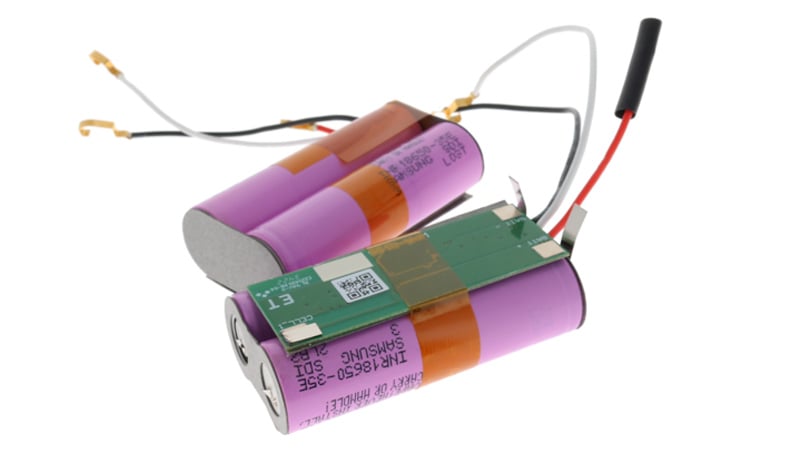Lithium batteries contain high density which is ideal when powering electronics and applications that require a large amount of power over an extended time. However, the battery chemistry is unstable. These batteries can experience overcharging, over-discharging, and discharging that occurs too fast. When the following actions occur, the battery can become damaged, have a diminished lifespan, or even create a safety hazard.
Protection boards for lithium batteries offer monitoring protection. Low-voltage lithium batteries require a protection board. When using high-voltage lithium batteries, a battery management system (BMS) is typically chosen since these systems contain more functions for monitoring the state of the battery pack.
Main Parts of a Protection Board
A protection board consists of integrated circuits (ICs), metal-oxide semiconductors (MOS) switches, capacitors, resistors, negative temperature coefficient thermistors (NTCs), positive temperature coefficient thermistors (PTCs), memory, ID, and other auxiliary devices. You can find protection boards as standard catalog items from a supplier, as you would get them customized based on the battery pack size, voltage, amp-hour ratings, chemistries, and any added functions.
Most ICs are currently manufactured in the Asia region, specifically Taiwan, as the following are commonly used around the world:
- 8261
- DW01+
- CS213
- GEM5018
You can also obtain custom-built protection boards with your custom battery packs. This arrangement is ideal since the battery manufacturer will have a greater understanding of the protection needs of the custom pack that they design for the customer. So, the protection board would cater to these design requirements.

Custom battery pack with protection board.
For some battery packs, other types of features are desired, such as cell balancing and fuel gauging. When additional functions are added, it is recommended to obtain a BMS that can be tailored for both the device and the battery pack.
Functions of a Protection Board
The main function of the protection board is to monitor the state of charge (SoC), temperature, voltage, current, and state of health (SoH) of the battery pack. The MOS is controlled by the control IC. The MOS is always turned on during normal functions. If the battery pack goes outside normal thresholds that are programmed into the circuit board, the IC instructs the MOS to switch to the off position. This function helps to protect the battery pack. Let's take a deeper look at how the protection board functions when there is overcharging, over-discharging, or a short circuit.
Overcharge Protection
The battery pack will experience normal charging when connected to the charger. As the voltage rises, the IC will monitor to see if the charge state of the battery pack goes over the normal charging limit of 4.4v. If this issue occurs, the 3rd output voltage pin disconnects, and the switch tube becomes closed. Both the protection circuit and the battery cell remain in this disconnected state until the voltage load is discharged indirectly. Once the voltage reaches normal levels, the output voltage pin and the overcharge control tube is turned on. Normal charging can be done to the battery pack again.
Over-Discharge Protection
Lithium batteries have a discharge limit of 2.3v. Going below this rating can damage the battery cell. While the pack is going through normal discharging while in use with the connected device, the IC monitors the discharge rate using resistance. If the battery pack goes beyond the discharge threshold, the IC disconnects the 1st output voltage pin as the switch tube becomes closed. The battery cell's discharge circuit is cut off and the cells will no longer discharge. When proper charging voltage is applied to the cells, the outage voltage pin is turned back on, and the switch tube is reconnected. The battery cells can now receive a charge from a charger.
Over Current and Short-Circuit Protection
Some devices may pull out too much of a charge in too fast of a short time span. To protect the battery cell and MOS tube, the protection board enacts discharge protection to the cell, turning off the pins and disconnecting the switch tubes.
The short circuit protection function is similar to the over-current protection function. The two electronic switches are the equivalent of two resistors that contain a very small amount of resistance. If the load voltage reaches over 300mA immediately, the voltage pin is turned off and the switch tube is disconnected. This feature helps protect the battery cell.
Certification of Protection Boards
All lithium battery cells, BMS, and protection boards undergo certification. UN/DOT 38.3.5 involves the shipping and transportation of lithium batteries. Other certifications include the IEC 62133 as well as UL 2054, UL 2580, and UL 2271. These certifications will be based on whether the battery cell and protection circuit are shipped separately if they are shipped with the device in the same package and if the battery pack is installed in the device when it is shipped. Certification may also be specific to an industry. There are certifications for batteries installed in light vehicles, wheelchairs, household devices, and electric bikes.
Keep in mind that the certification only applies to the battery pack and protection board sent for testing. If any changes are made to the battery cells or to the protection board, they must go back through recertification due to those changes. The certification also does not pass from one manufacturing company to the next if you decide to switch suppliers. The battery cell and protection board have to again undergo certification.
Summary
All lithium batteries must have a protection board or BMS connected to the battery cells. The customer must also obtain certification for the cell and BMS system. Keep in mind that customizations can be performed to the protection board so that it can properly monitor the features of the battery cell.
Key Takeaways
- Protection Boards Are Essential for Lithium Safety: Due to lithium’s high energy density and volatile chemistry, protection boards are critical for preventing overcharge, over-discharge, and dangerous short circuits that could lead to failure or hazards.
- Protection Boards vs. Battery Management Systems (BMS) : Low-voltage lithium packs typically use protection boards, while high-voltage packs often require full BMS solutions that provide advanced functions like cell balancing and fuel gauging.
- Custom Designs Yield Better Results: Protection boards tailored to a custom battery pack are more effective than off-the-shelf options, as they can be designed to match the battery’s voltage, capacity, chemistry, and performance needs.
- Multiple Layers of Protection: A protection board monitors the state of charge, temperature, voltage, current, and health. If any value exceeds its safe range, the board disconnects the circuit to prevent damage.
- Certifications Are Mandatory and Non-Transferable: All lithium protection systems must be certified (e.g., UN/DOT 38.3, UL 2054). Any design changes or supplier switches require re-certification, as previous certifications do not carry over.
















